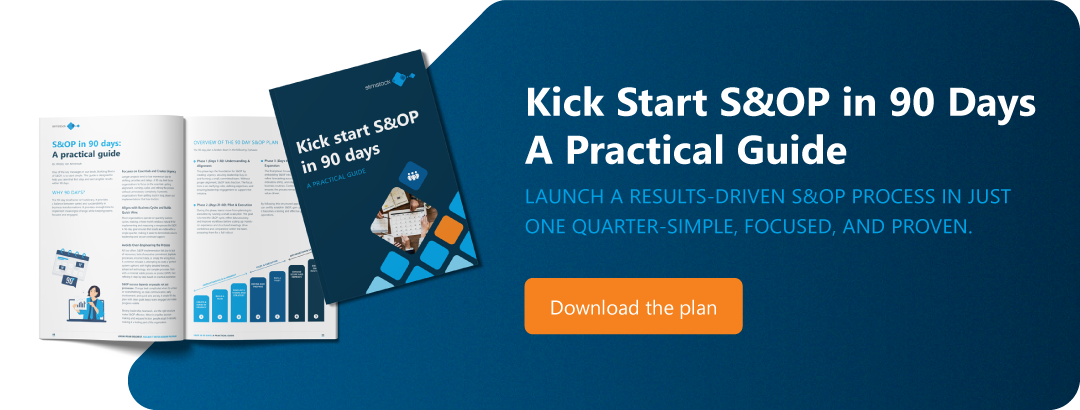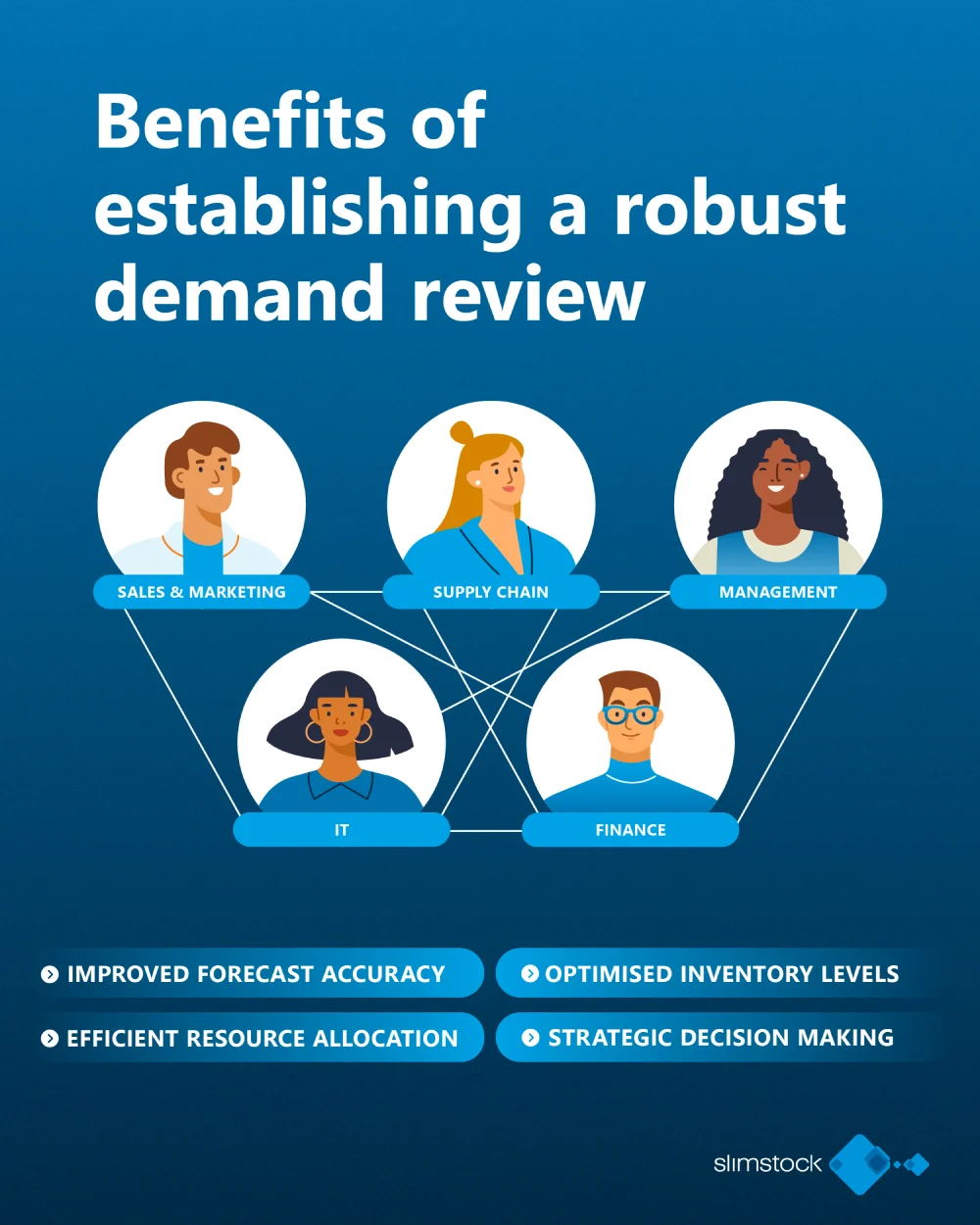Table of contents
Table of contents- Who’s who in your demand review?
- A cheat sheet for a more collaborative demand planning process
- What is a demand review?
- What are the benefits of demand review?
- What steps are involved in demand review?
- What are the key roles and responsibilities in the demand review?
- Conclusion: Final thoughts on demand review
A cheat sheet for a more collaborative demand planning process
Let’s face some hard truths: You don’t have a time machine, and there’s no crystal ball to predict the future. But you still need a reliable view of future demand to drive your entire operation.
Forecast accuracy is essential. However, as generations of supply chain leaders, who have invested countless hours in the pursuit of better forecasts, can attest, there is no such thing as a ‘perfect’ demand forecast.
Forecast accuracy is often treated as an absolute. Yet, achieving a reliable forecast isn’t about a single outcome. It’s about the direction and bandwidth of the error. And to understand this, you need a process to bring different perspectives for future demand together for a proper conversation.
And for a good discussion, you need the right people and a platform for open discussion. Enter the demand review process.
What is a demand review?
Demand review is a structured process within the Sales and Operations Planning (S&OP) framework. Focused on assessing, validating, and aligning the assumptions, the demand review process involves analysing historical sales data, market trends, promotional activities, and strategic business inputs. The result is a more reliable demand forecast that the whole business has confidence in.
During the demand review process, the forecast is elevated from a simple projection to a decision-making platform where cross-functional teams, such as sales, marketing, finance, and operations, collaborate to understand demand drivers, identify gaps, and reach a consensus on expected demand.
What are the benefits of demand review?
A good demand review sets the precedent for having a more accurate demand forecast. And so, the better your demand review process, the more reliable your demand assumptions should become. This is why engaging voices from across a mix of cross-functional teams is crucial.
However, the business benefits of establishing a robust demand review are far-reaching:
1. Improved forecast accuracy
A demand review will enhance accuracy by incorporating historical data, market intelligence and input from your Sales and Marketing teams
2. Optimised inventory levels
Delving into demand forecasts creates a greater understanding and awareness of demand drivers. By adjusting inventory decisions around a more realistic picture of future demand, supply chain teams can ensure optimal availability while minimising costs and diminishing the risk of obsolescence.
3. Efficient resource allocation
With greater alignment on anticipated demand, you can better allocate the resources at your disposal to balance supply with demand. Whether this means optimising your working capital investment, prioritising strategically important products or navigating outbound constraints, the result is a more efficient operation.
4. Strategic decision making
Accurate demand forecasts create informed decisions to take advantage of market opportunities and navigate emerging risks.
What steps are involved in demand review?
The demand review process is not about achieving absolute precision. It’s about building confidence into your demand assumptions.
Typically, the demand review process follows key steps. The process begins with validating the baseline forecast, using historical data and algorithms to establish a statistical foundation.
Next, cross-functional teams must collaborate to enrich the forecast by integrating market insights, promotions, new product plans, and strategic inputs, capturing what the numbers alone can’t predict.
The forecast is compared against the budget to identify gaps and misalignments that may require corrective action or escalation. With this insight, teams prepare for the demand review meeting, consolidating data, aligning assumptions, and identifying key discussion points.
Finally, we conduct the demand review. At this point in the process, cross-functional stakeholders validate assumptions, resolve discrepancies, and align on a consensus demand plan to create a single, unified view of future demand that drives supply chain, financial, and strategic decisions forward.
- Historical sales data
- Forecast accuracy
- Trends and seasonality
- Statistical forecast
- Baseline forecast
- Possible trends and biases
- Adjustment recommendations
- Sales team inputs
- Marketing plans
- Market shifts
- Macroeconomic trends
- Enriched forecast
- Key assumptions
- Risks and opportunities
- Budget
- Gap analysis
- Finalized forecast
- Gap analysis
- Risks and opportunities
- Open actions from past S&OP cycles
- Demand Review meeting deck
- Key discussion points and recommendations
- Demand Review meeting deck
- Key discussion points from previous steps
- Signed-off Consensus forecast
- Agreed-upon assumptions and risk mitigations
- Action items
- Documentation for the Supply Review
What are the key roles and responsibilities in the demand review?
Successful demand reviews rely on the input of the right stakeholders. Sales, Marketing, Finance, and Supply Chain should all be at the table, along with Product and Commercial teams, where needed.
It shouldn’t be Sales Vs Marketing. Or anything that borders on competition. This process is to help everyone in the company. Each group offers a different lens—Sales and Marketing bring customer and market context, Finance keeps the plan grounded in targets, and Supply Chain ensures it’s operationally realistic. Together, they shape a shared view of future demand that supports better decisions and smooth execution:
Sales team
Role:
- Demand forecasting and customer insights.
Responsibilities:
- Analyse historical sales data, market trends and customer feedback for forecasting future demand.
- Provide input on pricing strategies, product promotions and sales targets.
Operations Team
Role:
- Capacity planning and production scheduling.
Responsibilities:
- Evaluate production capabilities and capacity constraints to determine the feasibility of meeting the projected demand.
- Develop production plans, schedules and resource allocation strategies to align with the sales forecasts.
Supply Chain Team
Role:
- Inventory management and logistics.
Responsibilities:
- Monitor inventory levels to align with demand forecasts.
- Coordinate with suppliers to ensure timely delivery of raw materials and components.
- Optimise logistics operations to meet customer demand, while minimising costs and lead times.
Management Team
Role:
- Decision making and alignment.
Responsibilities:
- Oversee and guide the overall S&OP process.
- Make strategic decisions based on the insights and recommendations from various stakeholders.
- Ensure alignment between the demand forecasts, operational plans, financial targets and overall business objectives.
Finance Team
Role:
- Financial analysis and resource allocation.
Responsibilities:
- Conduct financial analysis on the projected demand to determine revenue forecasts, cost estimates and profitability analysis.
- Provide input on resource allocation decisions, budgeting and financial targets.
Conclusion: Final thoughts on demand review
Rather than benefit one team over another, a great demand review process will ensure the strategic alliance between sales forecasts and wider company objectives. This is what makes them so critical to your success.
They analyse various elements, validate forecasts, and ensure collaborative engagement with key teams and stakeholders. Ultimately, your demand review process should create a deeper understanding of your market dynamics and operational capacities.
The importance of aligning your demand plan within the company cannot be overstated. Especially when you think about its impact on key aspects of your business performance. Factors like customer satisfaction and inventory management aren’t things to take lightly.
It’s the survival of the fittest. And the fittest tend to make the best decisions. Made by strategic thinking, created on the back of great demand reviews.
The insights you’ll unearth in your demand reviews will be invaluable. You’ll spot emerging demand patterns and market trends and help your business to capitalise on new opportunities and mitigate the threats from market volatility.
Ultimately, your demand review process should epitomise the intersection of strategy and execution within S&OP.







